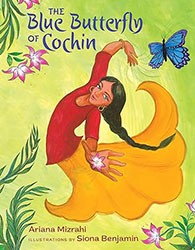Jane Breskin Zalben’s work has always been premised on her ability to connect with children, expressing their feelings about the world with respect and compassion. In A Bear for Bimi, she narrates the story of Bimi, a Muslim immigrant boy and Evie, the Jewish girl who, with her parents’ support, reaches out to him in his loneliness. Other members of the community, of diverse backgrounds, also help to create a warm and welcoming environment for a family which has suffered losses before finding a haven in the United States. Yevgenia Nayberg’s richly colored illustrations bring depth to this timely reminder about the powers of opening our doors to strangers.
Much remains unsaid in the book, keeping the story universal and accessible. Evie’s parents announce that a new family, “from far away,” will be their neighbors; Evie immediately associates the Saids with her own grandparents, who also traveled to America long ago. When she rushes outside to meet the newcomers, she notices a boy singing in a language which she cannot understand. Bimi’s origins are less important to Evie than the fact that he has been uprooted and needs a friend. Evie’s father, who wears a kippah, begins to help Bimi’s family, who are dressed in a way which identifies them as Muslims. There is no editorializing about specific religious or ethnic differences. Instead, the Gold family’s actions, and the Said family’s gratitude, represent the way that people should naturally interact, without prejudice or suspicion.
The community in the book is diverse; a Muslim woman brings the Saids a welcome mat, an African American neighbor supplies them with a lamp, and the artistic Lionis present a quilt in the form of an American flag. The Schwartz family’s five daughters, (like Tevye in Sholom Aleichem’s stories) are enthusiastic bakers who sweeten the Saids’ new home with cherry strudel and honey cake. There is one dissonant note, a fearful older woman named Mrs. Monroe, representing those Americans who reject a pluralistic vision of their country. Even Mrs. Monroe turns out to be easily convinced by one good deed that Bimi and his family are not her enemies. Zalben’s understated and poetic text keeps the characters from being mere symbols.
Nayberg’s pictures are beautifully composed, using geometric forms and a bright and deep palette. Placing characters and objects at different angles, she gives each scene a sense of quiet drama. Bimi’s mother, wearing a bright yellow dress and red hijab, offers Mrs. Monroe tea and cake. A door frames her elegant figure. The difficult Mrs. Monroe stands to the side, her arms folded, enclosed in her own space. In contrast, when the whole neighborhood meets to share a meal, the diners face one another, touching, gesturing, and listening. Many pictures play with symmetry, such as one where Evie and her mother walk together posed almost identically, each carrying gifts for the Saids with the same sense of purpose. Readers will find their eyes drawn to many different elements, from the assortment of foods on a table to the expression on Bimi’s face as he embraces Evie’s gift of a worn stuffed bear. This is a reassuring story about family, community, and both the Jewish and American traditions of welcoming strangers.
This highly recommended storyincludes an afterword about helping immigrants, notes on the author and illustrator, and instructions for making a stuffed bear.
Emily Schneider writes about literature, feminism, and culture for Tablet, The Forward, The Horn Book, and other publications, and writes about children’s books on her blog. She has a Ph.D. in Romance Languages and Literatures.





